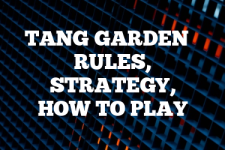Ginkgopolis: Guide to the Tile-Based Game – Rules, Instructions & Strategy
Introduction
Ginkgopolis is a super cool tile-based game that’s all about building a city of the future. It’s a mix of urban development, resource management, and strategic planning which I find to be really engaging. The game was designed by Xavier Georges and came out in 2012. It quickly got a lot of attention for its unique gameplay and beautiful design.

In Ginkgopolis, players compete to build the highest and most resource-efficient city by using cards, tiles, and a bit of luck. The game is known for being a bit complex at first, but once you get the hang of it, it’s really rewarding. So, let’s dive in and see what it’s all about!
Quick Tip for Ginkgopolis
Always keep an eye on your resources and plan a few moves ahead. It’s easy to get caught up in the moment, but Ginkgopolis rewards players who think long-term.
Rules for playing Ginkgopolis
Alright, let’s get into the rules of Ginkgopolis. The game is played over several rounds, and each round has three main phases: the Card phase, the Building phase, and the Urbanization phase. Players start with a hand of four cards and a few resources. On your turn, you can choose to develop a new building, add a floor to an existing building, or exploit a building for resources. You’ll use the cards in your hand to decide your action, and then you’ll draw new cards to replace them.
One of the key things to remember is that the color of the buildings matters. There are three colors: blue, yellow, and red. Blue buildings give you resources, yellow buildings score points during the game, and red buildings score points at the end. You’ll also want to pay attention to the letters and numbers on the tiles, as they help you figure out where you can build.
When you add a floor to a building, you’ll stack a tile on top of another one. This can give you some cool bonuses, like extra resources or points. But be careful, because other players can swoop in and build on top of your buildings too!
At the end of the game, you’ll score points for the buildings you’ve constructed, the resources you’ve collected, and any bonus points from cards. The player with the most points wins!
Equipment and Setup for Ginkgopolis
Before you start playing Ginkgopolis, you need to set up the game. You’ll need the game board, which has a bunch of spaces for the tiles. Each player gets a starting set of resources and a few starting tiles. The tiles come in different types: resource tiles, building tiles, and urbanization tiles. You’ll also have a deck of cards that match the tiles on the board.
To set up, you place the starting tiles on the board in a specific pattern. Then, you shuffle the cards and deal four to each player. You’ll also set up a supply of resources and a stack of extra tiles nearby. Now you’re ready to start building your city!
How to Play Ginkgopolis and Game Mechanics
- Key Game Mechanics: Players use cards to take actions, build tiles to create buildings, and manage resources to keep expanding their city.
- Setup: Place the starting tiles, deal cards, and prepare resources.
- Gameplay: Players take turns using cards to build or exploit buildings. They can also urbanize to expand the city.
- End of the Game: The game ends after a certain number of rounds or when certain conditions are met. Players then tally up their points to see who wins.
How to Win at Ginkgopolis
Winning at Ginkgopolis is all about balance. You need to build efficiently, manage your resources well, and keep an eye on what your opponents are doing. It’s important to have a mix of different building types and to take advantage of the bonuses they offer. You also want to make sure you’re scoring points throughout the game, not just at the end.
Another key to winning is to be flexible. Your plans might change based on what cards you draw or what other players do. So, be ready to adapt and make the best of each situation. And don’t forget about urbanization! Expanding the city can give you more options and help you control key areas of the board.
Best Strategies for playing Ginkgopolis game
Now, let’s talk strategy. One of the best ways to win at Ginkgopolis is to focus on a particular type of building. If you can get a lot of the same color, you can create powerful combos that give you a ton of points or resources. But, you also need to be careful not to put all your eggs in one basket. If other players see what you’re doing, they might try to block you or steal your buildings.
Another strategy is to keep an eye on the urbanization tiles. These can be really powerful because they let you expand the city and potentially take over areas that other players were counting on. If you can control the urbanization process, you can control the flow of the game.
And don’t forget about the cards! The cards you have in your hand can make or break your strategy. Try to keep a good mix of cards so you always have options. And if you see a card that would be perfect for another player, sometimes it’s worth taking it just to keep it away from them.
Scenarios
Let’s say you find yourself in a tough spot where another player has built over your building. Don’t panic! Look for ways to use your cards to either build around them or exploit the buildings for resources. You can also try to urbanize in a new area to get away from the competition.
On the flip side, if you’re in a good position with a strong set of buildings, think about how you can protect them. Maybe you can build around them to make it harder for others to take over, or you can use urbanization tiles to expand in a way that benefits you.
Frequently Asked Questions about playing Ginkgopolis game
- Q: How many players can play Ginkgopolis?
A: Ginkgopolis can be played with 1 to 5 players. - Q: How long does a game of Ginkgopolis usually take?
A: A game can take between 45 to 75 minutes, depending on the number of players and their experience with the game. - Q: Can I play Ginkgopolis solo?
A: Yes, there are rules for a solo version of the game. - Q: What happens if I run out of resources?
A: You need to plan your moves to ensure you don’t run out of resources. If you do, you’ll have to adjust your strategy and maybe focus on exploiting buildings for a while. - Q: Is there a way to block other players from building?
A: You can’t directly block players, but you can make strategic moves that make it harder for them to build where they want.
External Links
For more information on Ginkgopolis, check out the publisher’s website or look for video tutorials that can help you get a better grasp of the game. Remember to always refer to the official rulebook for the most accurate and detailed instructions.
Official Ginkgopolis Publisher Website
Ginkgopolis Rulebook [EN/PDF]

Eve Brownlee was a gamer before gaming communities on the internet were a thing. Eve grew up playing traditional, standard deck card games like Rummy and Bezique, taking an interest in the classics Backgammon and Chess. Parlor card games like Bridge continue to keep Eve active in the community. After a long career, primarily in horticulture for USDA in Maryland, Eve now travels and writes on The Pineapple (pineapples.info) and contributes to Quora/Pinterest topics. Contact Eve via email.



